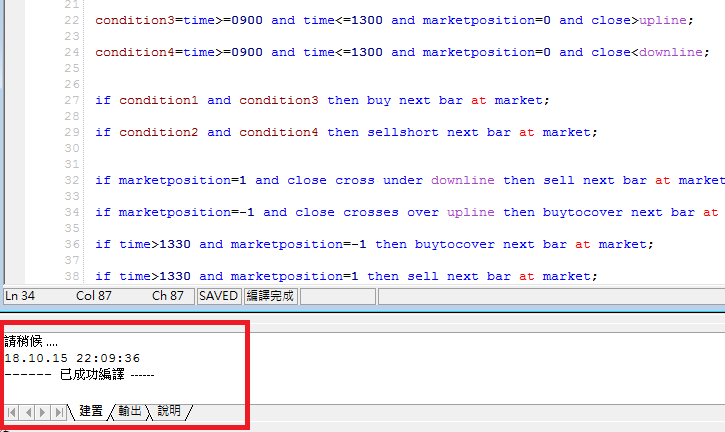
完整策略的架構 需要幾個條件 1.決定交易商品 2.交易的型態(當沖或留倉) 3.進場交易的模式(順勢或是逆勢) 4.加入濾網條件 5.平倉出場的條件(停損或停利),以下是簡單的範例說明
[IntrabarOrderGeneration=true]{當根K棒內交易模式 True or False}
input: {用來設定可外部調整的參數}
var:upline(high),downline(low); {自訂變數}
{定義每天支撐壓力上下的軌道}
if date<>date[1] then begin
upline=highD(0);
downline=lowD(0);
end;
{用condition設定進場交易的時間以及開盤的漲跌幅當作濾網 }
condition1=openD(0)>=closeD(1)*m;
condition2=openD(0)<=closeD(1)*n;
condition3=time>=0900 and time<=1300 and marketposition=0 and close>upline;
condition4=time>=0900 and time<=1300 and marketposition=0 and close<downline;
{符合條件時進場作多或做空}
if condition1 and condition3 then buy next bar at market;
if condition2 and condition4 then sellshort next bar at market;
{多單的停損}
if marketposition=1 and close cross under downline then sell next bar at market;
{空單的停損}
if marketposition=-1 and close crosses over upline then buytocover next bar at market;
{當沖策略需要寫收盤前最後出場的時間}
if time>1330 and marketposition=-1 then buytocover next bar at market;
if time>1330 and marketposition=1 then sell next bar at market;
寫好策略之後按F3編譯,確定編譯成功 就可以套用到multicharts的主圖跑跑看回測的績效了。這是一個簡單的順勢突破策略

小心得: 先有交易的想法,用文字條列式敘述,再逐一轉換成powerlanguage語法;語法編譯成功不代表邏輯上一定沒有問題,需要放到技術分析圖上面比對買賣訊號;有出現買賣訊號不表示一定可以真實交易,要檢視策略本身的可行性最好觀察一段時間
根據過去回測的數據做策略調整,每個人的標準不同,對績效的要求與風險的控管程度也不同,投資人可根據過去的績效表現評估未來的交易方式
以上心得分享 歡迎留言討論。 或是追蹤我的 FB粉絲頁 ![]()
![]() https://www.facebook.com/upup12341234
https://www.facebook.com/upup12341234




 留言列表
留言列表
